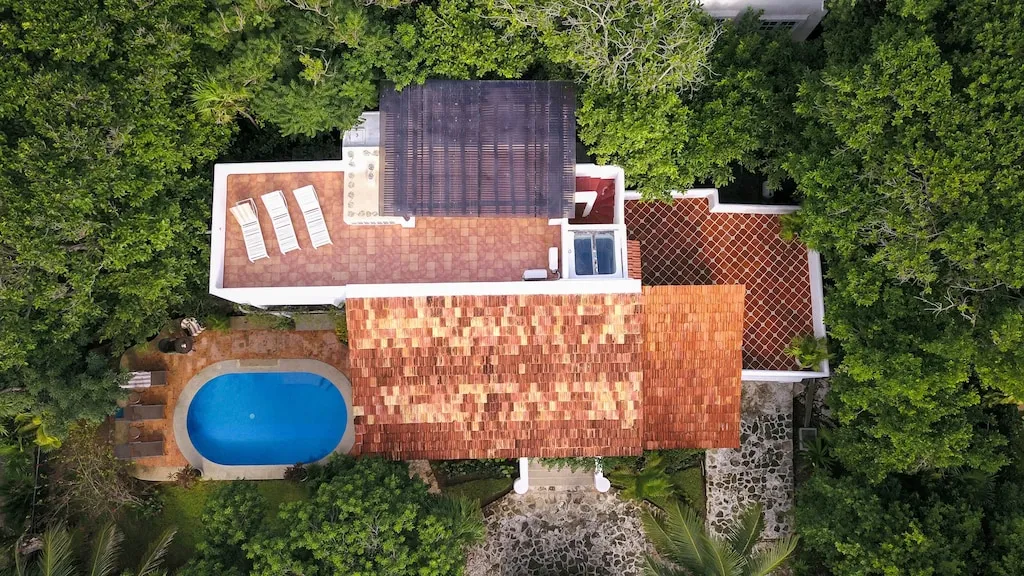Our Story
Letter from the legacy owner
Todd & Lola,
Renee and I want to thank you for the great time we had at Casa Chohom. We are so happy with every thing you’ve done to the house. We were so worried that whoever bought the house would tear it down and build some kind of 10 bedroom mini hotel instead of preserving the house and working to improve what we built.
With respect to the house, I want to fill you in on a couple of things. First, why is it called Chohom? One of the reasons I was interested in buying in Playa in was its proximity to the great fishing down in Ascension Bay. I am an avid fly fisherman and the availability of fishing for bonefish, permit, and tarpon was very attractive to me. When I bought the house I immediately hired Angel Islas, an architect who still lives in Playa to prepare plans for an extensive remodeling of the house.The house was the first one built in Playacar (in 1986) and was built by one of the developers. It needed extensive repairs and updates. The renovation took about six months. While that was proceeding I made many trips to Playa and read extensively about the Yucatan and the Mayan culture. One of the first books I read was an English translation of the the defense prepared by Friar Diego de Landa for his appearance before the Spanish Inquisition. Landa was an early leader of the Catholic Church in the Yucatan in the 1500s. In that position he did his utmost to destroy all traces of Mayan history and culture. He destroyed Mayan books, stellae(large stone tablets) recording Mayan history, and he was ruthless in suppressing any expression of Mayan religion or culture.
Fortunately for archeologists, his written defense of his activities in the Yucatan included translation of some Mayan hieroglyphics, a table of Mayan numerals, some description of the Mayan calendar, a translation of a list of Mayan celebrations, and other keys which were crucial to the eventual ability to translate the written traces the Mayans left behind.
One of the annual celebrations recorded by Landa was Chohom. Chohom was the celebration of fishing and fishermen. I couldn’t think of anything more appropriate!
Since the house was built so early, there was still a large supply of Spanish roof tiles available. The result is that the tiles on the roof are from the 1500s. They were used as ballast in vessels sailing from Spain and offloaded in the Yucatan and replaced with other cargo for the return trip to Spain. That supply of tile was quickly exhausted by the building boom caused by the development of Cancun starting in the mid 1970s. Those tiles haven’t been available for over 30 years. They may not be any better than modern tiles but they do have history.
There are a couple of books I would recommend; Friar Landa’s defense used to be available in the gift shops at the Cancun airport but I haven’t seen in in some years. There is a book by Michel Peissel titled The Lost World of Quintana Roo. It is a recounting of an incredible trip that Peissel took on foot in the 1950s from Isla Mujeres all the way down the coast to Belize.
I hope you enjoy your trip we sure enjoyed ours.
– Russ
1986
The creation
The house was the first one built in Playacar and was built by one of the developers. It needed extensive repairs and updates. The renovation took about six months. While that was proceeding I made many trips to Playa and read extensively about the Yucatan and the Mayan culture


HISTORY
Mayan Culture
One of the first books I read was an English translation of the the defense prepared by Friar Diego de Landa for his appearance before the Spanish Inquisition. Landa was an early leader of the Catholic Church in the Yucatan in the 1500s. In that position he did his utmost to destroy all traces of Mayan history and culture. He destroyed Mayan books, stellae (large stone tablets) recording Mayan history, and he was ruthless in suppressing any expression of Mayan religion or culture.
Fortunately for archeologists, his written defense of his activities in the Yucatan included translation of some Mayan hieroglyphics, a table of Mayan numerals, some description of the Mayan calendar, a translation of a list of Mayan celebrations, and other keys which were crucial to the eventual ability to translate the written traces the Mayans left behind.
One of the annual celebrations recorded by Landa was Chohom. Chohom was the celebration of fishing and fishermen.
Now
Chohom
Since the house was built so early, there was still a large supply of Spanish roof tiles available. The result is that the tiles on the roof are from the 1500s. They were used as ballast in vessels sailing from Spain and offloaded in the Yucatan and replaced with other cargo for the return trip to Spain. That supply of tile was quickly exhausted by the building boom caused by the development of Cancun starting in the mid 1970s.
Those tiles haven’t been available for over 30 years. They may not be any better than modern tiles but they do have history.
There are a couple of books I would recommend; Friar Landa’s defense used to be available in the gift shops at the Cancun airport but I haven’t seen in in some years. There is a book by Michel Peissel titled The Lost World of Quintana Roo. It is a recounting of an incredible trip that Peissel took on foot in the 1950s from Isla Mujeres all the way down the coast to Belize.

